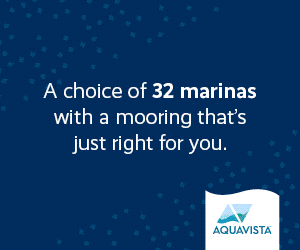Moorings
The mooring you choose can makes a big difference to your boating life. What are the options and how do they compare?
• Marina • Basin or lay-by • Boat club • Online • End of garden. Which is right for you? How much to pay? How to decide?
Choosing your mooring
Choosing the right mooring makes a big difference to your boating life. It’s the starting point for your boating trips, dictating where you can go in a weekend or longer break. Your boat will probably spend more time at its berth than away from it – so you’ll want peace of mind when you’re not there. And, needless to say, it’s your biggest annual boating expense.
Five years ago, finding a mooring was often a headache. With demand far outstripping supply, you could be faced with long waiting lists, or settling for second best. But with many new marinas opening in recent years, it need no longer be a worry. You can decide upon your ideal mooring and, budget permitting, you have a fair chance of getting it.
Types of mooring
Marinas
An ‘off-line’ mooring is one away from the main line of the canal. They come in many forms, but marinas are the most common – dedicated basins for mooring, usually purpose-built, but sometimes converted from a gravel lake or even an old canal arm.

Typically, ‘finger pontoons’ extend into the centre of the marina; each boat is allocated a berth alongside one of these. Canal marinas can reach over 600 berths in size, and river marinas might be even larger!
Most early marinas were built by a boatyard or hire-base, seeking to get the most from their canalside site. These days, new marinas are often built as businesses in their own right, sometimes by companies which operate half a dozen such sites across the waterway system.
Facilities at marinas vary greatly – from simple rural basins with no facilities, to the latest luxury berths with your own individual pontoon. As a general rule, there’ll be sanitary facilities on site (toilets, Elsan emptying, and sometimes showers), a diesel pump, and often coal and gas. Most berths will have a 240V mains electricity socket, which is billed individually, and a water tap. Wifi internet is increasingly common.
There will often be some basic security, such as a locked entrance to the mooring area, though the posher marinas have locked gates on each pontoon entrance. Many marinas will have someone on site at all times, whether an employee of the marina itself or its associated boatyard, or a ‘caretaker boat’ – a residential boater who has agreed to act as ‘eyes and ears’. This doesn’t just guard against vandalism: on river navigations, the marina staff will keep an eye out in case of rising levels.
Having a boatyard and surveyor on site can be invaluable when you need jobs done on the boat. Since most marinas will ask to retain a spare set of keys for your boat, the engineers can carry out the work without you needing to be present. Some marinas will also have a chandlery for DIY items and boating essentials.
Most rural marinas have car parking. Don’t rely on it with urban marinas – but you’re more likely to be within reach of a railway station!
Inevitably, all this comes at a price, and a marina berth will be more expensive than a bankside mooring in the same area. Some people simply find that marinas are not their cup of tea, characterising them as “floating caravan parks”.
Pros and cons of marina moorings
| For | Against |
| Secure | More expensive |
| Sanitary facilities | Atmosphere doesn't suit everyone |
| Electricity and water at most berths | |
| Boatyard and chandlery often on site |
Basins and lay-bys
Off-line moorings aren’t just gated communities in the middle of nowhere. Especially in urban areas, you’ll find dedicated mooring basins with many of the facilities of marinas.
You sacrifice a little seclusion (though most such basins have good security arrangements) and gain a practical town centre location. Facilities can vary greatly. You may enjoy all the facilities of a marina, but sometimes there’ll just be a couple of water taps on site and maybe an Elsan point.

Often these are historic locations, such as those where the River Severn meets its ‘tributary’ canals – Stourport, Worcester and Gloucester – and there’s certainly an appeal to mooring in such a historic spot. Since these are existing locations rather than purpose-built sites, the berths are sometimes fitted around the space available, giving the chance of a reduced-facilities mooring at a discount rate.
A second type of basin, sometimes known as a ‘lay-by’ mooring, is where a boatyard owner has cut away part of the bank next to his base – either for end-on pontoon berthing, or parallel to the main line. You benefit from the facilities of the boatyard, and good security from the watery moat (that is, the canal) between you and the towpath! But you’ll see more passing traffic, especially on Saturdays if there’s a hire-fleet at the location, and of course working boatyards have their own sounds throughout the day.
Pros and cons of basin and lay-by moorings
| For | Against |
| May have the facilities of a marina | Less secluded |
| Handy locations | Facilities may vary |
Boat clubs
For a truly social experience, look for a boat club. At these moorings, the members of the club help out with the maintenance of the site, saving money in the process. There's often a club-house and always a friendly atmosphere. Several clubs organise cruises for their members, whether just up to a picnic spot - or along an adventurous tideway!

Boat club moorings may be online or offline. You may not be guaranteed the at-berth facilities of a modern marina, but the club-house usually has everything from showers to a copy of WW to read. Most clubs on the canal system are members of the Association of Waterways Cruising Clubs, and offer reciprocal moorings at each others' locations. Thames clubs are grouped in the Association of Thames Yacht Clubs.
Pros and cons of boat club moorings
| For | Against |
| Friendly | Facilities vary |
| Good value | You have to do the work! |
| Reciprocal mooring with other clubs |
Online moorings
No, it’s nothing to do with the internet. An on-line mooring is one that’s on the main line of the canal, either on the towpath side or the opposite bank (the ‘off-side’).
On canals, towpath moorings are run by the navigation authority – in the case of most canals this is the Canal & River Trust. Off-side moorings may be run by either CRT or a private landowner, though the latter will still have to pay CRT a fee for every berth. On rivers, on-line moorings are usually controlled by the adjoining (‘riparian’) landowner.

Compared to marinas, you pay less and get less. Facilities may be sparse or non-existent: if you’re lucky, there’ll be a water point within hosepipe distance, but otherwise you’ll need to cruise a short way to refill your tank. Electricity is less likely still. Security varies by site: towpath moorings are by their nature insecure, while off-side moorings may be behind a locked gate or accessed over private land.
The plus side? You might get an amazing spot: a famous canal junction, a beautiful view, or simply the nearest berth to your home. And, of course, you’re saving money.
For many people, though, it’s more than that – they’ll tell you that on-line moorings are the only way to do it. Where better to start your holiday than on the canal itself, with nature and heritage all around, rather than in a modern basin? The choice is yours.
On rivers, there are often on-line moorings at locks, specially adapted for rising and falling levels. These are run by the navigation authority (such as the Environment Agency on the Thames, Canal & River Trust on the Severn).
Pros and cons of online moorings
| For | Against |
| Cheap | Fewer or no facilities |
| A real waterway experience | Less secure |
End of garden moorings
If you're lucky enough to live by a waterway, you may be able to moor your boat at the bottom of your garden.

This is far from a universal right. Indeed, if it’s one of your criteria for a new house, you should check with your solicitors and with the navigation authority. Nor is it free of charge: you may have to pay a fee to the authority, perhaps 50% of the current price for a no-facilities mooring nearby.
But it’s a tempting proposition. You’ll have few worries about security. There are electricity and water at the berth, assuming your extension lead and hosepipe are long enough. And as for whether there’s an engineer on-site – well, that depends how handy you are with a screwdriver…
Pros and cons of end-of-garden moorings
| For | Against |
| Cheap | Don't assume you're entitled to it |
| Ultimate convenience | |
| Facilities are up to you |
Buying and paying for moorings
Though there are more marina berths than five years ago, many marinas still have a waiting list of potential moorers. Perennially popular areas, such as the Braunston region, are the most likely to have queues. By contrast, new marinas take a while to fill up, and frequently offer good deals to tempt new boaters in.
Traditionally, marina berths have been priced per foot. A berth advertised at £40 per foot will cost £2,400 per annum for a 60ft boat. That said, if the marina's berths are 60ft long, it makes little difference to them whether there's a 60-footer or a 40-footer moored on it - so you'll sometimes find minimum lengths, maximum lengths, or per-berth pricing. Check the small print carefully. On wide waterways, many marinas will impose a surcharge (of 50% or thereabouts) for wide-beam boats.

Fees are usually paid every three, six or 12 months, often with a discount for the latter. You'll usually need to give a month's notice before vacating a berth. A few marinas have introduced long-term contracts or bonds (up to 25 years), where you get a massive discount on the annual rate in exchange for a long-term payment.
The Canal & River Trust when it comes to pricing, operates eBay style auctions with guide and reserve prices; as each bid is submitted, the price is ratcheted up until the closing date is reached. If you're prepared to play the game, there are genuine bargains to be had this way, subject to a reserve price on each mooring.
You will still need a cruising licence when you're moored in the marina - well, usually. This is stipulated in the 'Connection Agreement' that the marina signs with the navigation authority, as part of which the marina hands over a cut of your mooring fee. A few marinas (no more than 20 or 30 across the CRT system), however, have their own connections which can't be stopped up, or pre-date these agreements. If moored in one of these, you might be able to save a little money by buying short-term licences whenever you venture out.
Some marina groups allow their moorers to swap moorings within the group, should you fancy a change of scenery.
Where should you moor?
We won't pretend it's always a complicated decision. You might have fallen in love with a particular spot. Maybe there's a marina on your favourite waterway, just a short train ride from home. If that's the case, good luck - if not, here are a few factors to think about.

Wide vs narrow
It sounds obvious, but if you have a widebeam boat, you'll need a wide waterway to moor it on. The opposite is also frequently true: many narrowboaters dislike wide locks, and would prefer to moor on a narrow canal.
Locks
Speaking of which... love them or hate them? If you're in the latter camp, a marina in the middle of a lock flight will quickly pall.
Congestion
If most of your boating will take place on summer weekends, have a thought to congestion spots. Where there are many moorings in an area, queues can sometimes arise at 'bottleneck' locks. During the week, and off-season, it's less of a problem.
Access
Car parking will be the clincher for some, but a railway station can also be useful: with careful planning it allows you to extend your cruising range (out one weekend, get the train back, come back the next).
Facilities

You might be confident you don't need at-berth electricity or water, but think: do you have a solar panel to keep your batteries topped up? Is there a water point within easy distance? What about diesel?
Winding holes
If you're mooring online, you'll have to set off in the direction your boat is pointing - so a nearby winding hole is essential if you want to go the other way. Marina boaters needn't worry, but even then, the location of winding holes may determine your Saturday afternoon cruise.
Junctions
A nearby canal junction doubles your cruising routes - one of the reasons why the Braunston area is so popular. Moor at a river/canal junction and you can enjoy both types of cruising. Find the cruising guide for your intended area, and work out how many weekend and week-long options you'll have.
Water
Too much or too little? If you're planning to do a lot of winter cruising, a river mooring may not be the place for you; floods mean that many river boats stay tied up from October to March. On the canals, summer closures due to lack of rainfall are an increasing worry, and this too may affect your choice.
Pubs
Need we say more? But consider a Friday night: after a long drive up the motorway, you've arrived at your marina. It's 8pm, and the last thing you feel like doing is getting the pots and pans out. Is there somewhere good to eat nearby? Use our Pub Finder to explore the location of pubs near your chosen mooring site.
Other boaters
Just as you wouldn't move next to a church and complain about the bells, don't moor up next to a hire-base and then complain about the novice drivers, nor next to a wharf and complain about the freight.
Vacancies
So you've identified your ideal marina... only to find it's full up. Bad luck! But don't forget you can chop and change: put yourself on the waiting list, and book yourself in somewhere else for three months.






